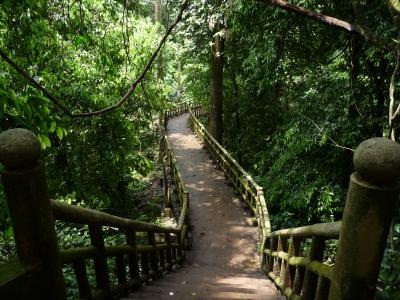- Vietnam Overview
- Main Cities in Vietnam
- Regions in Vietnam
- Other Cities in Vietnam
- Getting to Vietnam
- Getting Around Vietnam
- Language in Vietnam
- Education in Vietnam
- Vietnam Activities
- Vietnam Attractions
- Vietnam Money & Shopping
- Eating and Drinking in Vietnam
- Dress Code in Vietnam
- Gift Giving in Vietnam
- Public Behavior in Vietnam
- Art Performance
- Custom and Habits
Cuc Phuong National Park
Located on 2 limestone mountain ranges, the landscape of Cuc Phuong is a wonderfully rich ecosystem. Apart from verdant karst mountain and the lush valleys, the limestone formations produced numerous caves, many of which are accessible for exploration.

Established in 1962, Cuc Phuong is the oldest and largest national park in Vietnam.
Situated 120 South-West of Hanoi, with a 22,200 - ha rainforest, Cuc Phuong National Park is the centerpiece of Vietnam’s conservation efforts and one of the most accessible parks in the country.
Located on 2 limestone mountain ranges, the landscape of Cuc Phuong is a wonderfully rich ecosystem. Apart from verdant karst mountain and the lush valleys, the limestone formations produced numerous caves, many of which are accessible for exploration.
Looking at "Nguoi Xua" Cave (Cave of the Early Man), you will see the two new discovered ancient tombs along with Neolithic remains and evidence of stone implements. You would have similar findings at the following caves: Trang Khuyet (Crescent Moon), Thanh Minh and Con Mong, and Hang Dan (well known for Bat).
In earlier times, Cuc Phuong was home to the Muong minority people and today, you can still see their traditional stilt houses. The rocky outcrops of Cuc Phuong contain very valuable archeological vestiges such as a fossilized sea reptile, dated at 200 - 230 million years old and evidence of prehistoric people, who lived in the forest some 7500 years ago.
As the oldest national park of Vietnam, Cuc Phuong is attached to a long-lasting history.In 1960, Cuc Phuong was turned into a forest reserve, and then granted a “National Park” 2 years later by President Ho Chi Minh for reminding his people of the environment’s core role in their life. Yet there had already been some relationship between mankind and Cuc Phuong before this event. The remains of prehistoric men dating 7,000-12,000 years ago have been found in the numerous caves in the park.
Diversified Flora-Fauna. Cuc Phuong is also popular for being home to a huge diversity of flora and fauna. The botanical richness of the forest is impressive since it supports a wide variety of flora species and patches of primeval forest, including ancient trees with thick clusters of roots, parasitic plants and ligneous creepers. Surprisingly, some plant species have been introduced from Burma, India, and Borneo. Stepping to the caves, you can find at entrances the ideal moisture conditions and light, you will feel relaxed when seeing clusters of growing orchards as well as vanilla, snow-white and butterfly orchids.
As regards fauna, the park has 97 species of mammals, 300 species of birds, 36 reptilian species, 17 species of amphibians, 11 species of fish and thousands of species of insects, most of which do not bite. A number of species in the park are listed on Vietnam Red Book of endangered species.
Visiting the park, no one could help keeping an eye on the primates; including macaques, gibbon, Francois' leaf monkey and slow loris. Besides, this park is the home for other mammals including bats, porcupine, squirrel, leopard, clouded leopard and jungle cat in Cuc Phuong. Migrant species include thrushes, flycatchers, tits, finches, pipits amongst others. Hornbills can also be spotted in the forest.
Entertainment activities. Should you are keen on cultural aspects, do not hesitate to join in the community-based eco-tourism and home-stays. Why don’t you take a trek to the Muong village where the hospitable local people offer you 1 or 2 nights' home-stay in their traditional stilt houses? This does bring you an opportunity to explore their culture and try out bamboo river rafting!
You can also discover excellent hiking opportunities, and spend some days trekking though the forest. Popular trails to 1000 year old tree, other ancient trees, silver cloudy peak and Muong village. Tourists may join night-spotting trips into the primary forest. These offer opportunities to see the more exclusive mammal species of the park, including the black giant squirrel, the Indian flying squirrel, samba deer and several small carnivores.
Do not forget to bring with you the binoculars because Cuc Phuong is home to a wealth of beautiful tropical birds, many of which are endemic in Vietnam and Indochina. Some of the 307 species of rare birds that you might encounter are the silver-pheasant, red-collared woodpecker, brown hornbill, bar-bellied pita, and so forth.
For further interests, we suggest you take a tour to biodiversity hotspots. At the moment Cuc Phuong has a total of 43 biodiversity hotspots. All of these are recognized by the scientific department of the national park and they offer you and excellent opportunity to study and see many different species of tropical plants.
One of the fantastic ways to experience Cuc Phuong is by cycling through the forest. Biking offers the visitor not only silence and a cool breeze, but it is also a great way to discover the more secretive animals and birds of the national park.
Suggested means of transport. Take a bus from Hanoi at Giap Bat Bus Terminal- the city’s southern bus terminal, to Nho Quan, then catch a motorcycle taxi to the park headquarters. The total travel time is 2.30 to 3.30 hours.
If you plan on making only a day trip to the park, you should go through a travel agency. However, if you’re going to stay for one or more nights then the public bus option is viable.

